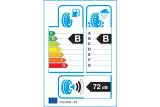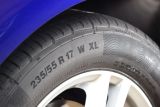A
Auto Express
Guest
Many people have no idea what the labels say on the sidewall of their tyres, and why should they? Punctures and blow-outs are pretty rare these days, and if their worn tyres are changed routinely by the garage it’s reasonable to expect the correct replacements.
It’s a bit different if you want to shop around for new tyres without relying on the garage. Ringing around all your local tyre fitters for best prices is a waste of time unless you know exactly what you’re looking for. That’s when you need to be able to decipher all those letters and numbers, to make sure your replacement choices are suitable – and safe.
• Best tyres to buy
Fitting the wrong sort of tyres can cause handling issues, and your tyres need to be a match for your car’s performance. So read on to find out about the writing on the sidewalls. The first thing you’re likely to spot on your tyre is the manufacturer and product name. Asking a garage to swap like-for-like is easy, but it’s often not the cheapest option, so unless you’re particularly wedded to a brand or type of tyre, this is something you can generally afford to overlook.
The rest of info provided is more critical, and there’s actually rather you can find out from the letters and numbers moulded into the sidewall. As well as the crucial UK/EU type approval mark, you’ll find info on the size of the tyre – both diameter and width – as well as its maximum speed and load ratings, and even its type of construction. If you’re looking at new tyres on a rack at the tyre fitters, you’ll also see stickers required by law that reveal economy and noise ratings, and also their rating for wet road grip.

All of this information can be taken into account when choosing new tyres, and this guide will help you make the most of the information on offer…
Tyre labelling: a complete guide
Every new tyre sold in Europe now comes with a label that provides information on wet grip, the tyre’s impact on fuel economy and the noise it generates, here’s how to decipher the codes:
Fuel efficiency
The first chart has a scale of A to G that shows fuel efficiency, where A is best. The difference between grade A and G can be up to 7.5 per cent, according to European Commission research. This chart measures rolling resistance, a force that resists motion when the wheel is turning, to determine efficiency.
Wet grip
The second chart uses the same A-G rating to show the amount of grip the tyre can generate on a wet road. The test used to evaluate wet grip is a braking test from 50mph, and the difference in stopping distance between each grade is between one and two car lengths.
Therefore the difference between the stopping distance of an A-rated tyre and a G-rated one could be 18 metres. If a tyre has a good fuel efficiency rating, then its wet grip score may be poor, because by reducing rolling resistance, wet grip is reduced, so you’ll need to strike a balance between decent performance in both regards.
Noise
The third chart illustrates the external noise generated by the tyre when it's travelling at 50mph. The noise is expressed in decibels (dB).
There’s also a symbol that looks a little like a wifi sign. One black arc means the tyre will be compliant with future legal limits, three black arcs represents the weakest performance and sits somewhere between the current maximum and forthcoming lower limits.
Exceptions
These regulations will apply to most tyres, but some types of tyre for cars, light commercial vehicles and trucks are excluded, including:
There’s a range of information printed on the side of a tyre approved for use on the road. As well as the name of the tyre manufacturer, you’ll also find digits relating to its size and speed rating.
Tyre sizes
On the side of a tyre – also called the sidewall – you’ll find a series of digits. We'll use the following example: 215 45 R16 91 W E4.
The first number – 215 in this example – shows the width of the tyre in millimetres.
• Car stopping distances: everything you need to know
The second number – 45 – shows the height of the sidewall as a percentage of the tyres' width. In this example, the tyre’s sidewall height is 45% of the 215mm width.
The letter R refers to the tyre’s construction. You’ll rarely see a letter other than R, as it refers to a radial tyre. This is the most common type of car tyre, and it uses steel and kevlar belts to help the tyre maintain its shape at higher speeds.

The next number – in this case 16 – refers to the size of the wheel it will fit. So our sample tyre will fit a wheel of 16 inches in diameter.
The next number – here it's 91 – shows the tyre’s load rating, but confusingly this doesn’t relate to the actual weight the tyre is able to carry. In this instance, 91 denotes the ability of the tyre to carry 615kg. Load ratings range incrementally from 62 (265kg) to 126 (1,700kg).
The following letter – W – is the tyre's speed rating. You can find out more about this in the table below.
The final pair of digits – E4 – is an approval mark showing the tyre has been tested and approved by the European regulatory authorities. You should always check your tyres carry this approval.
What is a tyre speed rating?
The tyre’s speed rating represents the top speed that the tyre is capable of maintaining. A letter that appears on your tyre’s sidewall illustrates the rating (see example above).
• Best tyre pressure gauges 2019
It's essential that you choose a tyre capable of travelling at speeds in excess of your car’s maximum speed – even though every tyre is capable of maintaining speeds of more than 70mph.
You could find your car insurance invalidated by using tyres with a lower speed rating than appropriate for your car.
How do I find the correct rating for my car?
The tyre speed ratings for your car will be listed in your vehicle’s owner’s manual. Alternatively, check with your main dealer.
Tyre speed rating codes
If you're looking for new tyres then why not check out our guide to the best all-season tyres?
Continue reading...
It’s a bit different if you want to shop around for new tyres without relying on the garage. Ringing around all your local tyre fitters for best prices is a waste of time unless you know exactly what you’re looking for. That’s when you need to be able to decipher all those letters and numbers, to make sure your replacement choices are suitable – and safe.
• Best tyres to buy
Fitting the wrong sort of tyres can cause handling issues, and your tyres need to be a match for your car’s performance. So read on to find out about the writing on the sidewalls. The first thing you’re likely to spot on your tyre is the manufacturer and product name. Asking a garage to swap like-for-like is easy, but it’s often not the cheapest option, so unless you’re particularly wedded to a brand or type of tyre, this is something you can generally afford to overlook.
The rest of info provided is more critical, and there’s actually rather you can find out from the letters and numbers moulded into the sidewall. As well as the crucial UK/EU type approval mark, you’ll find info on the size of the tyre – both diameter and width – as well as its maximum speed and load ratings, and even its type of construction. If you’re looking at new tyres on a rack at the tyre fitters, you’ll also see stickers required by law that reveal economy and noise ratings, and also their rating for wet road grip.

All of this information can be taken into account when choosing new tyres, and this guide will help you make the most of the information on offer…
Tyre labelling: a complete guide
Every new tyre sold in Europe now comes with a label that provides information on wet grip, the tyre’s impact on fuel economy and the noise it generates, here’s how to decipher the codes:
Fuel efficiency
The first chart has a scale of A to G that shows fuel efficiency, where A is best. The difference between grade A and G can be up to 7.5 per cent, according to European Commission research. This chart measures rolling resistance, a force that resists motion when the wheel is turning, to determine efficiency.
Wet grip
The second chart uses the same A-G rating to show the amount of grip the tyre can generate on a wet road. The test used to evaluate wet grip is a braking test from 50mph, and the difference in stopping distance between each grade is between one and two car lengths.
Therefore the difference between the stopping distance of an A-rated tyre and a G-rated one could be 18 metres. If a tyre has a good fuel efficiency rating, then its wet grip score may be poor, because by reducing rolling resistance, wet grip is reduced, so you’ll need to strike a balance between decent performance in both regards.
Noise
The third chart illustrates the external noise generated by the tyre when it's travelling at 50mph. The noise is expressed in decibels (dB).
There’s also a symbol that looks a little like a wifi sign. One black arc means the tyre will be compliant with future legal limits, three black arcs represents the weakest performance and sits somewhere between the current maximum and forthcoming lower limits.
Exceptions
These regulations will apply to most tyres, but some types of tyre for cars, light commercial vehicles and trucks are excluded, including:
- • Retreads
- • Temporary tyres and space saver spares
- • Professional off-road or racing tyres
- • Studded tyres – if the metal studs are fitted
- • Tyres intended for cars registered before 1 October 1990
- • Tyres with a speed rating of less than 50mph
- • Tyres with a rim diameter of less than 254mm or more than 635mm
There’s a range of information printed on the side of a tyre approved for use on the road. As well as the name of the tyre manufacturer, you’ll also find digits relating to its size and speed rating.
Tyre sizes
On the side of a tyre – also called the sidewall – you’ll find a series of digits. We'll use the following example: 215 45 R16 91 W E4.
The first number – 215 in this example – shows the width of the tyre in millimetres.
• Car stopping distances: everything you need to know
The second number – 45 – shows the height of the sidewall as a percentage of the tyres' width. In this example, the tyre’s sidewall height is 45% of the 215mm width.
The letter R refers to the tyre’s construction. You’ll rarely see a letter other than R, as it refers to a radial tyre. This is the most common type of car tyre, and it uses steel and kevlar belts to help the tyre maintain its shape at higher speeds.

The next number – in this case 16 – refers to the size of the wheel it will fit. So our sample tyre will fit a wheel of 16 inches in diameter.
The next number – here it's 91 – shows the tyre’s load rating, but confusingly this doesn’t relate to the actual weight the tyre is able to carry. In this instance, 91 denotes the ability of the tyre to carry 615kg. Load ratings range incrementally from 62 (265kg) to 126 (1,700kg).
The following letter – W – is the tyre's speed rating. You can find out more about this in the table below.
The final pair of digits – E4 – is an approval mark showing the tyre has been tested and approved by the European regulatory authorities. You should always check your tyres carry this approval.
What is a tyre speed rating?
The tyre’s speed rating represents the top speed that the tyre is capable of maintaining. A letter that appears on your tyre’s sidewall illustrates the rating (see example above).
• Best tyre pressure gauges 2019
It's essential that you choose a tyre capable of travelling at speeds in excess of your car’s maximum speed – even though every tyre is capable of maintaining speeds of more than 70mph.
You could find your car insurance invalidated by using tyres with a lower speed rating than appropriate for your car.
How do I find the correct rating for my car?
The tyre speed ratings for your car will be listed in your vehicle’s owner’s manual. Alternatively, check with your main dealer.
Tyre speed rating codes
| Speed rating | Top speed |
| N | 87mph |
| P | 93mph |
| Q | 99mph |
| R | 106mph |
| S | 112mph |
| T | 118mph |
| U | 124mph |
| H | 130mph |
| V | 149mph |
| Z | 150mph+ |
| W | 168mph |
| Y | 186mph |
If you're looking for new tyres then why not check out our guide to the best all-season tyres?
Continue reading...

